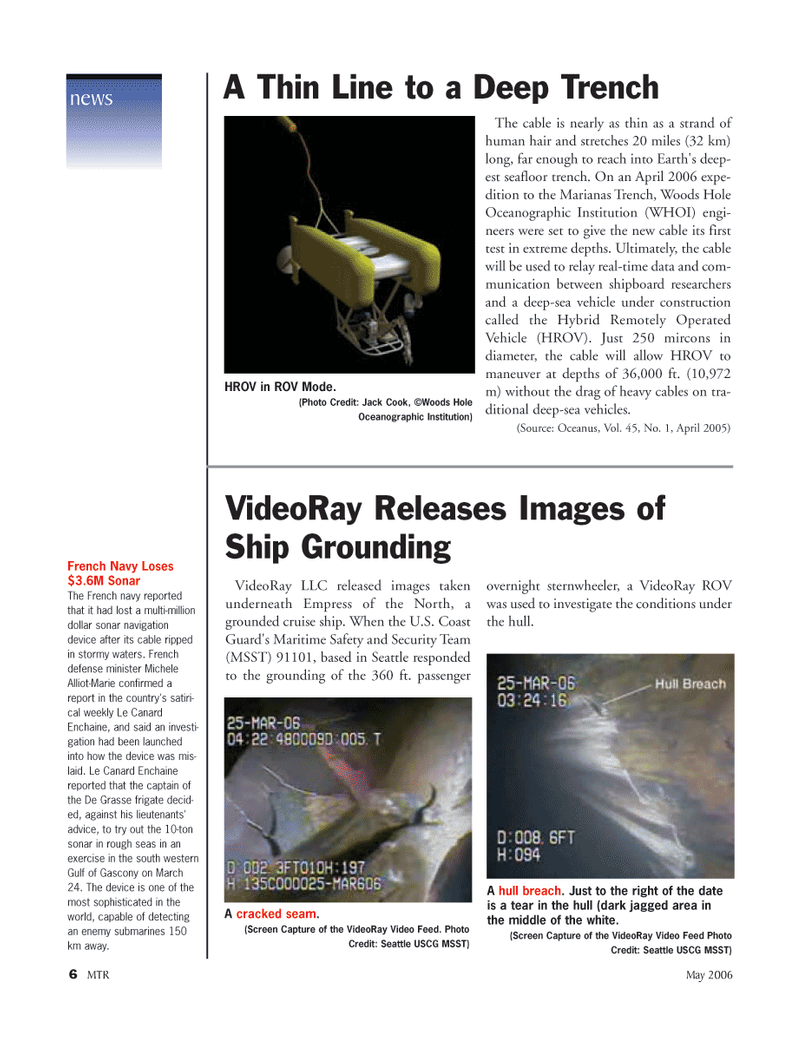
Page 6: of Marine Technology Magazine (May 2006)
The Communications Edition
Read this page in Pdf, Flash or Html5 edition of May 2006 Marine Technology Magazine
6 MTR May 2006
The cable is nearly as thin as a strand of human hair and stretches 20 miles (32 km) long, far enough to reach into Earth's deep- est seafloor trench. On an April 2006 expe- dition to the Marianas Trench, Woods Hole
Oceanographic Institution (WHOI) engi- neers were set to give the new cable its first test in extreme depths. Ultimately, the cable will be used to relay real-time data and com- munication between shipboard researchers and a deep-sea vehicle under construction called the Hybrid Remotely Operated
Vehicle (HROV). Just 250 mircons in diameter, the cable will allow HROV to maneuver at depths of 36,000 ft. (10,972 m) without the drag of heavy cables on tra- ditional deep-sea vehicles. (Source: Oceanus, Vol. 45, No. 1, April 2005) news
A Thin Line to a Deep Trench
HROV in ROV Mode. (Photo Credit: Jack Cook, ©Woods Hole
Oceanographic Institution)
VideoRay LLC released images taken underneath Empress of the North, a grounded cruise ship. When the U.S. Coast
Guard's Maritime Safety and Security Team (MSST) 91101, based in Seattle responded to the grounding of the 360 ft. passenger overnight sternwheeler, a VideoRay ROV was used to investigate the conditions under the hull.
VideoRay Releases Images of
Ship Grounding
A cracked seam. (Screen Capture of the VideoRay Video Feed. Photo
Credit: Seattle USCG MSST)
A hull breach. Just to the right of the date is a tear in the hull (dark jagged area in the middle of the white. (Screen Capture of the VideoRay Video Feed Photo
Credit: Seattle USCG MSST)
French Navy Loses $3.6M Sonar
The French navy reported that it had lost a multi-million dollar sonar navigation device after its cable ripped in stormy waters. French defense minister Michele
Alliot-Marie confirmed a report in the country's satiri- cal weekly Le Canard
Enchaine, and said an investi- gation had been launched into how the device was mis- laid. Le Canard Enchaine reported that the captain of the De Grasse frigate decid- ed, against his lieutenants' advice, to try out the 10-ton sonar in rough seas in an exercise in the south western
Gulf of Gascony on March 24. The device is one of the most sophisticated in the world, capable of detecting an enemy submarines 150 km away.
MTR#4 (1-16).qxd 5/8/2006 9:32 AM Page 8

 5
5

 7
7
